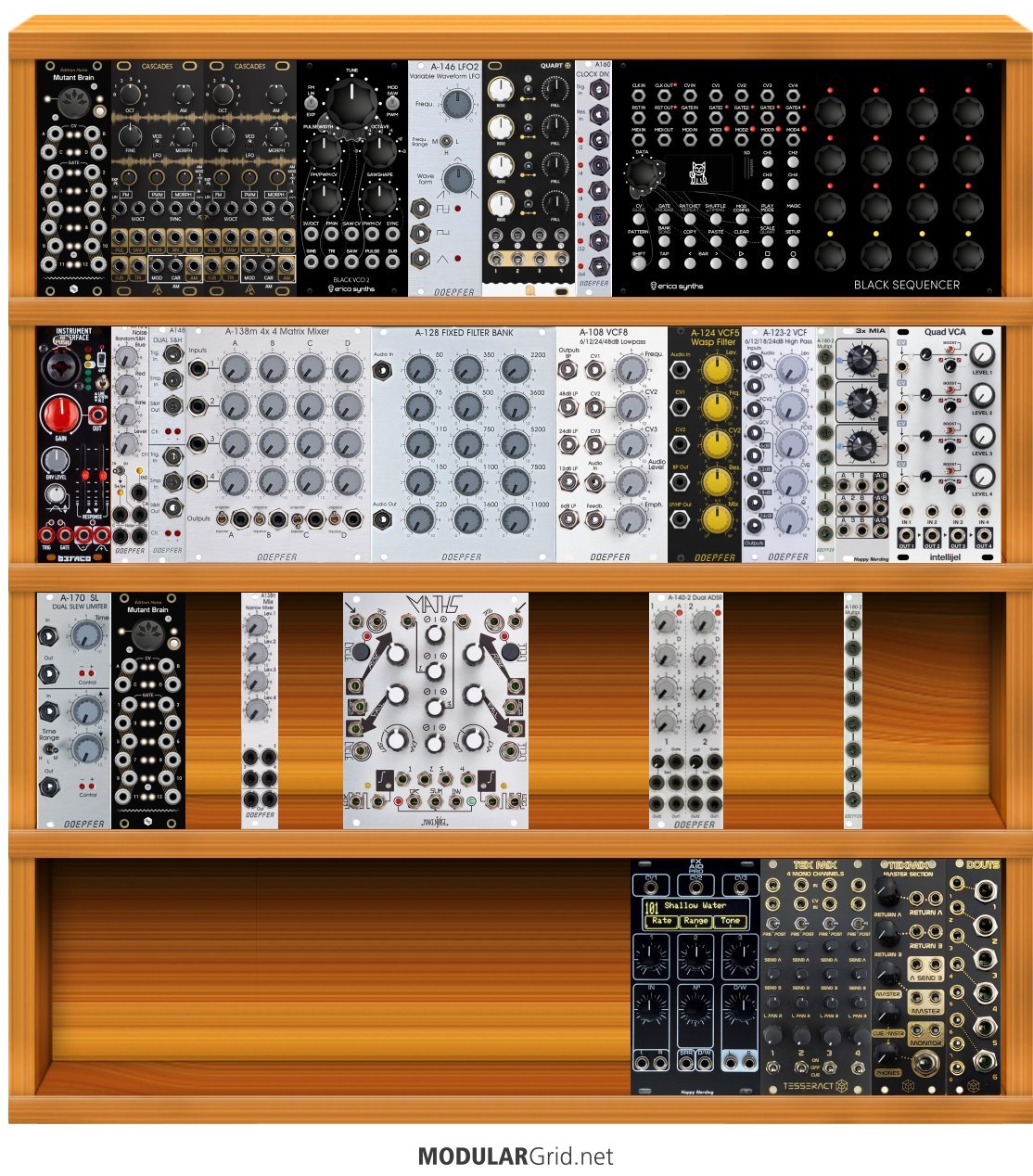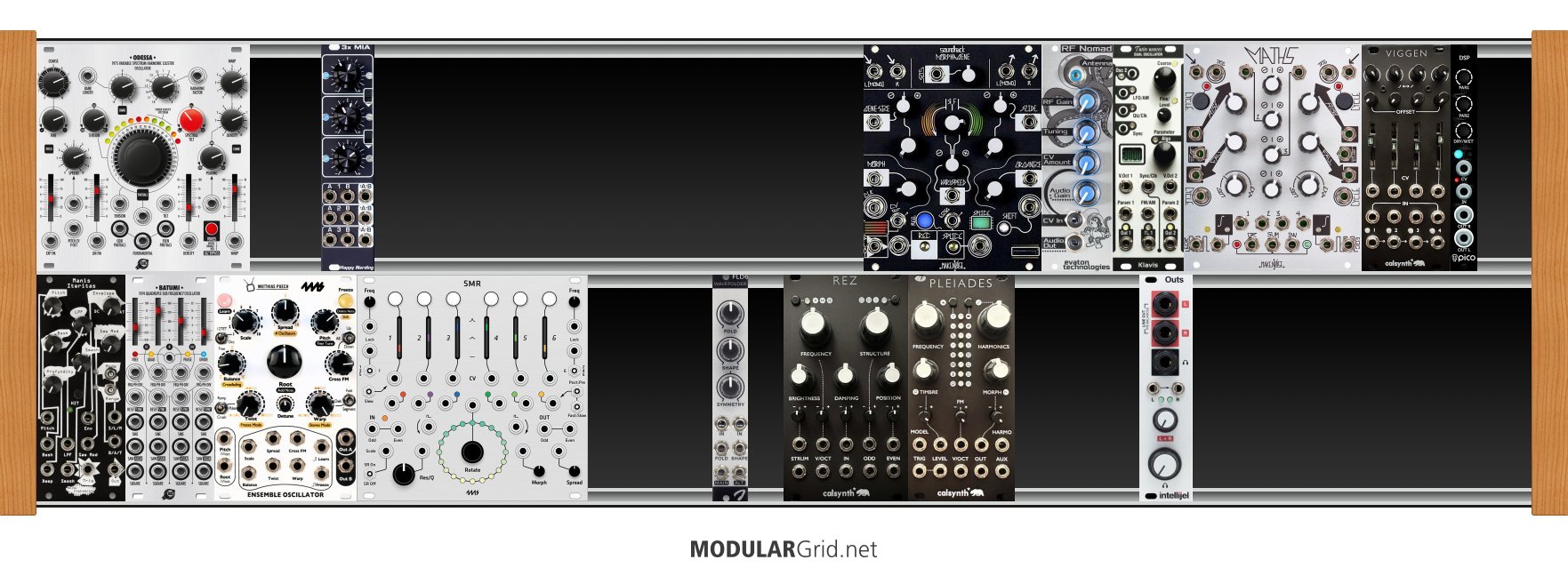NP... what I do is copy url & paste into post...
whilst you seem to have at least managed to get a decent mix of sounds sources, sound modifiers, modualtion sources and utilities... there's a lot of things I'd do differently... see my signature for some hints...
top row:
doepfer are not well known for midi -> cv modules... I'd not worry about this to start with... ie I'd drop the module...
the oscillators you've chosen... I'd probably want a 3rd - something different - either as the source for FM on one of these, or as a separate sound source...
I'm not convinced by the audio divider... what's your imagined use case for this?
clock divider ok - I use my clock divider as a squarewave sub-bass... audio in, square wave out (/2 =-1ve, /4 =-2ve) -> vca & filter
not convinced by the sequencer... I think there are better options out there... so why this one? also NB it has no quantizer built in so you need either a dual one - or a sequencer module with quantisation built in... also needs a clock input... so either you need a sequencer with clock built in or you'll need an external clock - if you want to sync to a DAW, via midi you'd need one of the doepfer modules that specifies sync - ie not the one you chose - or a different midi->cv module (mutant brain - is a very good option) - or sync via audio (I use a kick sample) - also this sequencer massively benefits from pairing with the controller...
middle row:
a lot of filters... but no other effects, I'd swap some out... add a multi-effect unit... an fx aid pro possibly 2... if 2 I'd only get 1 pro - the pro can be used as a cheat sheet for the other - delay and reverb (at a minimum) is a useful combination
I'd not spend money on a b-company fixed filter bank... if I wanted something similar I'd wait and buy a better one at a later date... I'd put a matrix mixer in it's place
the 2 mixers and 2 mults next to each other will be annoying... I'd also replace one of the mixers with a happy nerding 3 * MIA - not only can it mix, but it also can be used for attenuation/attenuversion/offset - which is incredibly useful to have (& yes I know that Maths has these - but you will almost definitely want to use them whilst you are using maths for something more interesting)
do you really need 2 adsrs? I'd look for a dual in the same space... or one that's voltage controlled, oroften less complex envelope generators work well in modular... ADs for example...
ah some vcas... not enough... get at least a quad cascading one... a veils clone, perhaps... vcas are for cv as well as audio... and even for audio they are for more than just shaping notes...
bottom row:
a-119 - it's useful, but noisy
dual slew - might be redundant (& I dislike this word with regard to modular) - maths is a dual slew! I'd drop this
ring mod... better to get the dual vc polarizer... it can do ring mod and other things and it's the same size...
maths (great module - download the 'maths illustrated manual' (work through it multiple times thinking about what, why & how) and a single lfo are not really enough modulation sources... I'd get a batumi & expander...
personally I'm not a big fan of scopes... I have an es8 so could use 1 in vcv rack and I also have 1 in the fx aid pro... neither of which i use that much... you can listen to any cv... just send it through a vcos pitch input...
mixer - you have all those filters - eq is a bit redundant (urgh) - I'd get a better mixer... again b-company (I try as much as humanly possible to avoid giving money to Uli!) if you want relatively inexpensive & absolutely must have EQ... then I'd go for an external mixer... I have an inexpensive yamaha mg12, which handles modular levels well - I wouldn't get one with fx built in though, just the base model - this will also save some rack space
so a 1/2 decent job... it's very 'east coast' subtractive dual mono-synth like... could probably do with a few different modules added - some logic and
whilst I understand that a full 9u rack can seem expensive (& this is probably 1 of the least expensive I've seen) it's not that bad... especially when compared to a lot of other musical instruments - and definitely not when compared to professional level custom instruments - try checking out cello bows (good ones cost multiples of this rack) - or to a lot of other hobbies (golf, scuba diving, skiing etc etc)
it's always useful to remember, apart from the b-company all eurorack manufacturers are tiny companies with very small runs of modules (250 is a very big run for most of them) & they are often manufactured in EU or North America - which is why they might appear 'expensive' - they're not FMCG - they're more slow moving niche goods
remember you don't have to buy all of this at once - buy the case and a minimum viable synth and add modules slowly, one or two at a time... you will learn more... and get more from your modular... plus as no plan survives contact with the enemy, which in this case is you... your plans/wants/needs will change over time... & the slower you go, the fewer side tracks you'll take - as you will find out what you are missing and then add it, rather than buying modules you find you don't use...
sometimes the more expensive module is cheaper in the long run - sequencers are a good example - for example a used metropolix might be a better buy than the a-155, as a starter sequencer, as it includes an internal clock and has a quantizer built in... amongst a load of other features - or a used erica black sequencer... more channels - so still good if/when you get more voices in the future, plus it has a modulation lane on each channel, quantisation, midi in, more steps etc etc
a minimum viable synth is a sound source, a sound modifier, a modulation source, a way to play and a way to listen... I'd add some basic utilities (the 3 * MIA, a quad cascading vca, a mult etc)
"some of the best base-level info to remember can be found in Jim's sigfile" @Lugia
Utility modules are the dull polish that makes the shiny modules actually shine!!!
sound sources < sound modifiers < modulation sources < utilities



